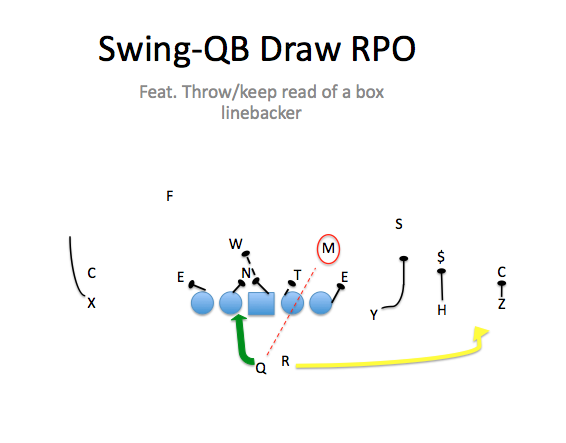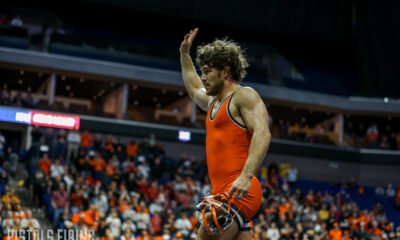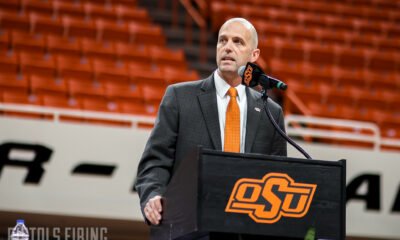Football
Film Look: Offensive Takeaways from OSU’s Bedlam Loss
Cowboy Back motion and the quick passing game were two common themes in this home loss.

Oklahoma State wrapped up the 2019 regular season with a 34-16 home loss to in-state rival OU. The Cowboys and Sooners each ran 61 plays and had nine offensive drives. However, Oklahoma scored touchdowns on four of those drives, while the Pokes only managed to score one lone TD early in the first quarter.
OSU did some interesting things on offense, which I’ll cover below, but they weren’t able to close offensive possessions with touchdowns and seemed to play too conservative at times. For this post, I’ll take a look at the OSU offense and talk about some things I liked, and some I didn’t like in the Cowboys loss to OU.
Cowboy Back Motion
Oklahoma State offensive coordinator Sean Gleeson moved the Cowboy Backs around pre-snap quite often this past Saturday. One of the primary reasons for doing this is to switch the strength of the formation by moving the Cowboy Back from one side to the other, possibly confusing the defense shortly before the ball is snapped.
The OC and quarterback can take a look at the defense and then move the Cowboy Back to where they best think they can gain leverage, not only in the running game, but in the passing attack as well. Pre-snap motion can cause a defense to tip their hand and expose what coverage they are in.
In this first clip below, you’ll see Cowboy Back Jelani Woods motioned from the inside receiver position at the top of the screen back to a fullback/h-back position to assist in pass protection for OSU QB Dru Brown. This also shifted the Sooner defense to open up the quick pass to running back Chuba Hubbard.
Next, we see Gleeson use the motion as “eye candy” by moving Woods from the H-back position on one side of the formation to the other. The OU linebackers shift to the side Woods motions to. The Cowboys then run outside zone away from Woods, and Hubbard busts it for a big gain.
On Hubbard’s touchdown run, you’ll see the Cowboys in a double wing set. Before the snap, Cowboy Back Dayton Metcalf motions from the wing at the bottom of the screen across the formation to assist as a lead blocker on this pin and pull sweep.
Along with this pin and pull concept, we saw some additional pulling linemen blocking concepts set up with this Cowboy Back motion, such as H-Counter. In the clip below, you’ll see Cowboy Back Logan Carter motion from one side of the formation to the other and position himself as the H-Back.
The running strength of the formation is now set to that side, but the Cowboys decide to run H-Counter back the other way. Carter pulls around the end along with the backside guard.
As I mentioned above, pre-snap motion can open things up in the passing game as well depending on how the defense adjusts to the movement. Here you’ll see Woods motion from the inside receiver spot at the bottom of the screen to a fullback spot on the opposite side of the formation.
As he does this, the OU defense shifts towards the motion side. This leaves wideouts Landon Wolf and Braydon Johnson on the outside lined up against two Sooner DBs who aren’t anywhere near the line of scrimmage, setting up a perfect screen opportunity.
You can see from the clips above that the Pokes found some early success with this motion in both their running game as well as through the air. However, after averaging 8.7 yards per carry in the first quarter, OSU averaged 3.5, 4.8 and 1.4 yards per carry in the following three quarters, respectively.
As I stated before, it seemed like Gleeson and Gundy wanted to control the clock and keep things conservative for the majority of this contest, and they just weren’t able to generate much offense with this game plan as the game progressed.
Quick Passing Game and RPOs
Brown did throw the ball down the field in this one. There were some deep shots to Johnson as well as Stoner, but his bread and butter seems to be the quick passing game. We saw his accuracy in this department on quick hitches, slants and out routes, as you’ll see in the following clips.
First, we see the quick hitch out to Johnson. Brown has perfect timing here, throwing the ball before his receiver has turned fully around, which allows Johnson to catch the ball, make a move and pick up some big yardage after the catch.
Next, we see a double slant concept, as Brown throws the ball where only his receiver can make a play on it.
Finally, Brown throws a nice ball to Stoner on the quick out route.
Something else Brown has found success with are the run-pass Options, or RPOs, which I touched on last week. Below we see a swing-draw RPO. See the diagram below for further detail.

The pass option here is the swing pass out to running back LD Brown, and the run option is QB draw. In the video below, you’ll see the OU linebacker follow Brown out of the box, leaving only four defensive linemen and one linebacker to stop the run. Upon seeing this, Brown makes his read to keep the football himself and picks up the first down.
That being said, the quick passing game and these RPOs will only get you so far. I thought the game plan, as it really did for a majority of the regular season, lacked the presence of deep shots over the middle. We saw Brown hit Johnson on a deep crossing route early on, but they never really went back to it. With the Sooner D loading up to stop Hubbard, it seemed like the right move to open things up, but we just never saw it.

-

 Football4 days ago
Football4 days agoFour-Star Wide Receiver Jaden Perez Commits to Oklahoma State
-

 Wrestling4 days ago
Wrestling4 days agoOSU Wrestling: Olympic Chances End for Cowboy Hopefuls
-

 Football2 days ago
Football2 days agoFour-Star Quarterback Adam Schobel Commits to Oklahoma State, Flips from Baylor
-

 Hoops2 days ago
Hoops2 days ago‘Keep Turning Over the Rocks’: Looking at the Portal Landscape as Lutz Looks to Solidify His First OSU Roster






